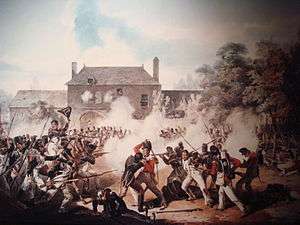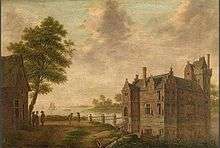Arrazola de Oñate
| House of Arrazola de Oñate | |
|---|---|
| noble family | |
 | |
| Country |
|
| Titles | |
| Founded | ±1450 |
Arrazola de Oñate (also written as de Arrazola Oñate) is a Belgo-Spanish noble family, originating from Oñati in the Basque Country, from which the history can be traced back to the early 14th century, holding high functions ranging from the military to feodal lords and councilors. Since the 17th century a branch has been living in the Spanish Netherlands, later to become the United Kingdom of the Netherlands and Belgium.[1]
Origin
The earliest proof of the name Arrazola that refers to this specific family is a made on court cases before the Royal Audiencia and Chancillería of Valladolid from the early 15th century. Proofs of nobility ('Uradel') issued in the 16th and 17th century however let the genealogy ascend up into the 14th century.[2]
Several members of the Arrazola family held public functions throughout the years in both the local region, as the capitals of Madrid and Valladolid. The extensive genealogy, and the exercise of public functions made this family a prime example of Hidalgos Solariego: they were considered most noble, were exempted from paying taxes, yet owned little real property. This was confirmed by several courts from 1711 to 1793, and by the Royal Chancillería of Valladolid in 1783.[3]
Juan Alexandro Arrazola de Oñate was born around 1580 and travelled with Isabella and Archduke Albert VII to the Southern Netherlands in order to become their chamberlain. In 1611 he married Beatrix Heath, the daughter of English nobleman Jerome Heath. His Spanish nobility was officially recognized in Flanders and Brabant in 1649.[4]
On 7 August 1647, King Philip IV of Spain made Juan's son, Marc, a Knight. Marc was Lieutenant general of the Falconers of Flanders and mayor of the Brugse Vrije from 1649 to 1659. The Brugse Vrije was a castellany in the county of Flanders, stretching between the North Sea, Sluis, Eeklo, Hooglede, Zarren and the river Yser. Later on he also became Royal Commissioner for the renewal of Bruges' magistracy in 1655, '66 and '67. He is buried in the Prinsenhof in Bruges.[5]
In 1654 Archduke Leopold Wilhelm of Austria, then-Governor of the Spanish Netherlands, made Marc's brother Jean-Jacques councilor and auditor in the Court of Accounts of Brabant, and councilor in the Raad van Financiën, managing the domains of the Habsburg ruler and performing the financial management. In addition to the hereditary nobility coupled to this position, Jean-Jacques was granted the title of Knight.[6]
Coat of Arms
The heraldic coat of arms is argent of colour as a symbol of purity, wisdom, innocence and joy. It features an uprooted oak in vert placed between two sable wolves, symbolising both strength and slyness.
Castles

Castle Hougoumont
The Castle Hougoumont located in Eigenbrakel was property of this Spanish family from mid-17th century until the end of the 18th century. The castle had a high-walled garden, an orchard, a park and was the home of the Lords of Gomont for 5 centuries. A couple of years after the death of the last Lord Arrazola de Oñate de Gomont, a member of the Seven Noble Houses of Brussels, the castle prominently featured in the Battle of Waterloo.
The castle was inherited by his widow, who after his death married Philippe Gouret de Louville, a major in the service of Austria. As the officer, 86 years of age, had insufficient funds to rebuild the castle after the Battle of Waterloo, he sold it on May 7, 1816 to François de Robiano.
Castle of Hombeek
The Castle of Hombeek, later to be called Castle Carmosteyn, was acquired by Ridder Jan-Jacob from the de Boccabella family in 1670. The moated castle became the property of the de Locquet family as they became the new Lords of Ophombeek in 1680.

Castle of Meldert
The feodal Castle of Meldert, build in the second half of the 17th century, was inhabited by the last Lord of Meldert: Marten-Jozef Arrazola de Oñate.[7] Under his tenure the region became a province of the French Republic. All noble privileges were abolished and the final curtain fell for the feudal era. Today, the Arrazola coat of arms is still part of the historical coat of arms of both Meldert and Lummen. The last remains of this castle disappeared in 1871.[8]
References
- ↑ I.S. VANDERWAEREN, Enkele aantekeningen over de Arrazola's de Oñate, in: Oost-Brabant 19-2, 1982
- ↑ X, "Linaje, armas y nobleza del apellido Arrazola", +-1646, Royal Library of Spain, bdh0000122670
- ↑ Ejecutoria del pleito litigado por Lorenzo, Pedro, Ignacio de Arrazola Oñate sobre hidalguía de sangre en propiedad y casa solar de Arrazola, 25-11-1783, Archivo de la Real Chancillería de Valladolid, ES.47186.ARCHV/6.8.1//REGISTRO DE EJECUTORIAS,CAJA 3501,39
- ↑ X., "Armoiries de la famille de Arrazola Onate y Garibay, certifiées par Diego Barreiro, roi d'armes de Philippe IV d'Espagne, Francisco Mendes, secrétaire du roi, Pierre Delaunay, roi d'armes pour le Brabant, Michiel Maurissens, roi d'armes pour la Flandre", 1649, Royal Library of Belgium n° 1433447
- ↑ A. DE BEHAULT DE DORNON, Bruges, séjour d’exil des rois d’Angleterre Edouard IV et Charles II, Bruges, 1931
- ↑ L. DUERLOO & P. JANSSENS, Wapenboek van de Belgische Adel, Brussels, 1992
- ↑ L. HEYNENS, Adel in Limburg, Pons Mosae, 2008
- ↑ P. MAAS, Notice historique sur les communes de Meldert et de Zeelhem, Diest 1876